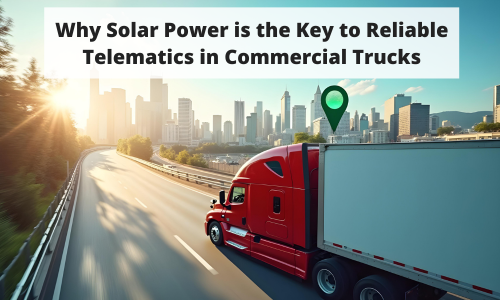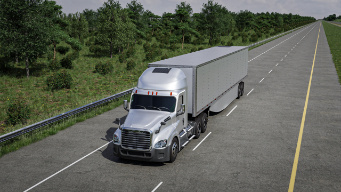
Telematics systems are essential in commercial trucking. They help track vehicle locations, monitor driver behavior, truck diagnostic systems for predictive maintenance and ensure cargo safety.
Both tractors and trailers use telematics, but their power needs can differ. Tractors typically use the truck’s main battery to power telematics, while trailers often rely on a smaller, separate battery.
Solar power offers a simple, reliable solution to keep telematics running smoothly on the tractor and trailer.
Let’s examine how solar energy efficiently and sustainably powers telematics on both parts of a commercial truck.
Take this blog post with you!
Telematics Systems on the Tractor
.png?width=350&height=186&name=Truck%20without%20trailer%20with%20a%20telematics%20system%20(350%20x%20186).png)
Overview of Tractor Telematics
Telematics systems on the tractor provide critical information on the truck’s location, engine health, speed, and driver behavior.
These systems are powered by the truck’s primary batteries, which must stay charged to keep the vehicle operational.
However, this setup creates issues if the truck is parked for long periods or turned off while the telematics system continues to draw power.
The Power Problem for Tractor-Based Telematics
When the telematics system relies on the truck’s main battery, power drain quickly becomes an issue.
If the truck's battery runs down while parked, it will result in jumpstarts, delays, battery wear, and often expensive battery replacements.
This disrupts schedules, increases maintenance costs, and reduces battery life.
How Solar Helps Tractor Telematics

A roof-mounted solar panel powers telematics systems without relying on the truck’s main battery.
This provides several benefits:
- Constant Power Supply: Telematics can stay on even when the truck is parked or off, allowing fleet managers to track vehicles at all times.
- Battery Preservation: Solar energy helps the main battery last longer and reduces the risk of unexpected battery drain by reducing strain.
- Reduced Downtime: Fewer jumpstarts and power-related delays mean trucks spend more time on the road, leading to smoother operations and lower maintenance costs.
Telematics Systems on the Trailer
.png?width=450&height=149&name=Truck%20with%20trailer%20and%20telematics%20system%20(450%20x%20149).png)
Overview of Trailer Telematics
Trailers often have telematics systems that monitor their location, temperature, and other cargo conditions.
Since trailers don’t have an engine or primary battery, they rely on a smaller, separate battery for power.
This battery must stay charged to keep the trailer’s telematics running, especially when detached from the tractor.
The Power Problem for Trailer-Based Telematics
Trailer telematics batteries are often smaller, so they can drain quickly between hauls or when trailers are disconnected.
If the battery dies, trailer data is lost, and fleet managers can’t monitor essential details like location and cargo temperature.
This creates a gap in fleet data, making it harder to ensure safe and efficient operations.
How Solar Helps Trailer Telematics
.jpg?width=350&height=197&name=Small%20solar%20panel%20supporting%20a%20telematics%20system%20(350%20x%20197).jpg)
A solar panel on the trailer keeps the telematics battery charged without relying on other power sources.
Here’s how solar helps:
- Continuous Monitoring: Solar power allows trailer telematics to run non-stop, providing data on location and cargo conditions at all times.
- Reduced Battery Drain: Solar panels charge the trailer’s battery even when idle, meaning less frequent recharges or replacements.
- Lower Maintenance: With a constant power source, trailers require less maintenance and fewer battery swaps, saving time and costs for fleet managers.
Proven Performance in the Field
Ross Joseph, VP of Operations for FleetPulse, provider of advanced trailer telematics insights, chose PowerFilm solar panels for their product, noting,
“Solar panels for our smart trailer telematics product is a clear choice. No matter the electronics added to a trailer, they are 100% dependent on tractor power to activate or charge a battery. Tractor power to trailer is dependent on driver operation and mutual well maintained electrical systems. One smart trailer in a month can be expected to connect with a multitude of tractors from different model years and maintenance best practices. PowerFilm Solar helps us engineer a solid product that keeps working for the customer no matter the condition.”
The Bottom Line
Telematics systems provide essential data for fleet management but need reliable power sources to stay active.
Solar power offers an ideal solution by keeping telematics systems powered on the tractor and trailer.
For the tractor, solar power protects the main battery, reduces downtime, and allows continuous data collection.
For trailers, solar energy ensures that the telematics system has the power to monitor location and cargo safety at all times.
Investing in solar power for telematics systems improves efficiency, lowers maintenance costs, and supports sustainable fleet operations.
Contact us today to learn how PowerFilm Solar will help you create a customized solar solution to reliably and efficiently keep your trucks moving and your data flowing.
Take this blog post with you!